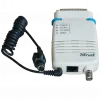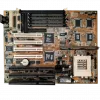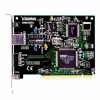OS/2 is a computer operating system, initially created by Microsoft and IBM, then later developed by IBM exclusively. The name stands for "Operating System/2," because it was introduced as part of the same generation change release as IBM's "Personal System/2 (PS/2)" line of second-generation personal computers. OS/2 is no longer marketed by IBM, and IBM standard support for OS/2 was discontinued on 31 December 2006. Currently, Serenity Systems International sells OS/2 under the brand name eComStation.
OS/2 was intended as a protected mode successor of PC-DOS. Notably, basic system calls were modeled after MS-DOS calls; their names even started with "Dos" and it was possible to create "Family Mode" applications: text mode applications that could work on both systems. Because of this heritage, OS/2 shares similarities with Unix, Xenix, and Windows in many ways.
The development of OS/2 began when IBM and Microsoft signed the Joint Development Agreement in August 1985. It was code-named "CP/DOS" and it took two years for the first product to be delivered.
OS/2 1.0 was announced in April 1987 and released in December as a textmode-only OS. However, it featured a rich API for controlling the video display (VIO) and handling keyboard and mouse events so that programmers writing for protected-mode no longer had to call the BIOS or access hardware directly. In addition, development tools included a subset of the video and keyboard APIs as linkable libraries so that family mode programs were able to run under MS-DOS. A task-switcher named Program Selector was available through the Ctrl-Esc hotkey combination, allowing the user to select among multitasked text-mode sessions (or screen groups; each could run multiple programs).
Communications and database-oriented extensions were delivered in 1988, as part of OS/2 1.0 Extended Edition: SNA, X.25/APPC/LU 6.2, LAN Manager, Query Manager, SQL.
The promised Graphical User Interface (GUI), Presentation Manager, was introduced with OS/2 1.1 in October, 1988. It had a similar user interface to Windows 2.1. The interface was replaced in versions 1.2 and 1.3 by a tweaked GUI closer in appearance to Windows 3.1.
The Extended Edition of 1.1, sold only through IBM sales channels, introduced distributed database support to IBM database systems and SNA communications support to IBM mainframe networks.
Version 1.2 introduced Installable Filesystems and notably the HPFS filesystem. HPFS provided a number of improvements over the older FAT filesystem, including long filenames and a form of alternate data streams called Extended Attributes. In addition, extended attributes were also added to the FAT file system.
Installation Disk A of Microsoft OS/2 1.3 (3.5" floppy disk).
The Extended Edition of 1.2 introduced TCP/IP and Ethernet support.
OS/2 and Windows-related books of the late 1980s acknowledged the existence of both systems and promoted OS/2 as the system for the future.











